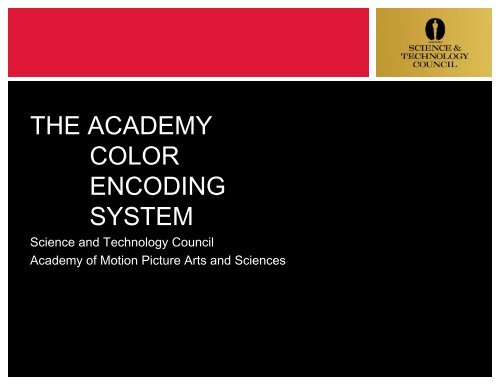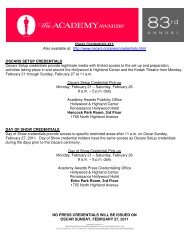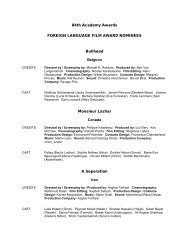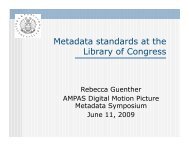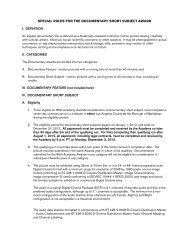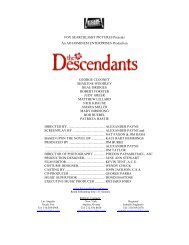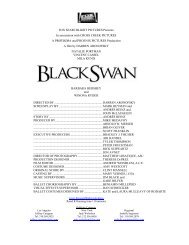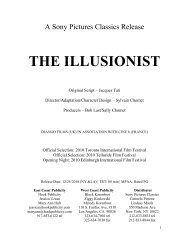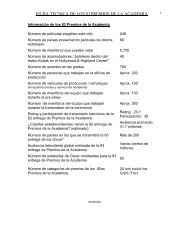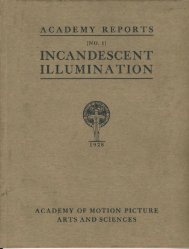the academy color encoding system - Academy of Motion Picture ...
the academy color encoding system - Academy of Motion Picture ...
the academy color encoding system - Academy of Motion Picture ...
You also want an ePaper? Increase the reach of your titles
YUMPU automatically turns print PDFs into web optimized ePapers that Google loves.
THE ACADEMY<br />
COLOR<br />
ENCODING<br />
SYSTEM<br />
Science and Technology Council<br />
<strong>Academy</strong> <strong>of</strong> <strong>Motion</strong> <strong>Picture</strong> Arts and Sciences
ACES Project Goals<br />
• Enable seamless interchange <strong>of</strong> high quality motion<br />
picture images regardless <strong>of</strong> source<br />
• Enable high dynamic range, wide <strong>color</strong> gamut, high<br />
precision (4K/16bit) workflows<br />
• Define <strong>the</strong> “Digital Source Master”<br />
• Define a path to an Archival Master<br />
• Co-exist with present practices and enable practical<br />
migration<br />
• Take results to appropriate Standards Development<br />
Organizations<br />
<strong>Academy</strong> Color Encoding System (ACES)<br />
®2013 A.M.P.A.S.
<strong>Academy</strong> Color Encoding System –<br />
Why?<br />
• Film is no longer <strong>the</strong> primary exchange format used<br />
in production<br />
• Increased need to interchange unfinished images in<br />
digital form<br />
• There are many, many, image file formats and<br />
<strong>encoding</strong>s<br />
• Existing standards are outdated, little (if any)<br />
metadata is exchanged<br />
• Today’s film stocks exceed <strong>the</strong> range <strong>of</strong> current<br />
10-bit DI <strong>system</strong>s<br />
<strong>Academy</strong> Color Encoding System (ACES)<br />
®2013 A.M.P.A.S.
Key ACES Components<br />
• Well-specified 16 bit image <strong>color</strong> <strong>encoding</strong>: ACES<br />
• Well-specified 16 bit film density <strong>encoding</strong>: ADX<br />
• Well-specified rendering transform: RRT<br />
• Well-specified scanner/recorder characterization<br />
and calibration<br />
• Well-specified data container, metadata<br />
• Result: a suitable format for archiving<br />
<strong>Academy</strong> Color Encoding System (ACES)<br />
®2013 A.M.P.A.S.
<strong>Academy</strong> Digital Source Master<br />
• Ideally:<br />
– Maintain <strong>the</strong> greatest possible fidelity from original<br />
source media<br />
– A destination for <strong>color</strong> correctors, digital cameras,<br />
renderers, scanners, telecines<br />
– Usable in as many parts <strong>of</strong> <strong>the</strong> digital workflow as<br />
possible, but still allows facilities to utilize <strong>the</strong>ir<br />
existing pipelines<br />
<strong>Academy</strong> Color Encoding System (ACES)<br />
®2013 A.M.P.A.S.
Brief Technical Overview<br />
• <strong>Academy</strong> Color Encoding Specification (ACES)<br />
– A Radiometrically Linear Light Encoding<br />
– Methodologies provided to get from any source<br />
(Film, Digital, etc.) into ACES<br />
<strong>Academy</strong> Color Encoding System (ACES)<br />
®2013 A.M.P.A.S.
Brief Technical Overview<br />
• Reference Rendering Transform (RRT)<br />
– Idealized replacement for Print Film Emulations<br />
– Extremely Wide Gamut and High Dynamic<br />
Range<br />
– Capable <strong>of</strong> supporting many looks, including<br />
those <strong>the</strong> outside <strong>the</strong> capability <strong>of</strong> <strong>the</strong> film <strong>system</strong><br />
<strong>Academy</strong> Color Encoding System (ACES)<br />
®2013 A.M.P.A.S.
Idealized System<br />
<strong>Academy</strong> Color Encoding System (ACES)<br />
®2013 A.M.P.A.S.
ACES Color Encoding Principles<br />
• Encodes scene exposures as <strong>the</strong>y exist at <strong>the</strong><br />
camera focal plane<br />
• Creative effects <strong>of</strong> filters, exposure choices,<br />
lighting, etc. are maintained<br />
• There will always be some inaccuracies in<br />
estimations <strong>of</strong> <strong>the</strong> scenes <strong>color</strong>s because <strong>the</strong>re is<br />
no perfect capture technology<br />
• Accuracy is important, but consistency is critical!<br />
<strong>Academy</strong> Color Encoding System (ACES)<br />
®2013 A.M.P.A.S.
ACES Color Encoding Principles - 2<br />
• Wide gamut <strong>encoding</strong>:<br />
– Encode all possible <strong>color</strong>s (cover <strong>the</strong> visible<br />
gamut)<br />
– RGB primaries to enable use as a working space<br />
• High dynamic range<br />
– Greater than 25 stops encoded<br />
• Floating point values<br />
– Preserves fidelity during artistic image<br />
manipulation<br />
<strong>Academy</strong> Color Encoding System (ACES)<br />
®2013 A.M.P.A.S.
ACES Color Encoding Details<br />
• Fixed RGB Primaries<br />
CIE x<br />
CIE y<br />
Red 0.73470 0.26530<br />
Green 0.00000 1.00000<br />
Blue 0.00010 -0.07700<br />
<strong>Academy</strong> Color Encoding System (ACES)<br />
®2013 A.M.P.A.S.
ACES Color Encoding Details<br />
• 16-bit half-floats<br />
– Value range from -65504.0 to +65504.0<br />
– Negative code values are valid<br />
e.g. {0.14, 1.00, -0.55}<br />
• “Calculation” Neutral Axis<br />
– CIE x = 0.32168, CIE y = 0.33767<br />
– Approximately CIE D60<br />
• Reference Midpoint “Grey”<br />
– ACES {0.1800, 0.1800, 0.1800} = CIE XYZ {0.1715, 0.1800, 0.1816}<br />
<strong>Academy</strong> Color Encoding System (ACES)<br />
®2013 A.M.P.A.S.
<strong>Academy</strong> Digital Source Master<br />
• Encoding: ACES<br />
• Image container:<br />
– Constrained version <strong>of</strong> OpenEXR file format<br />
accessed via <strong>the</strong> normal OpenEXR libraries<br />
• Contents <strong>of</strong> <strong>the</strong> file: ACES data + essential<br />
metadata<br />
<strong>Academy</strong> Color Encoding System (ACES)<br />
®2013 A.M.P.A.S.
ADX Density Encoding<br />
• <strong>Academy</strong> Density Exchange Encoding<br />
– Printing Density: how a film print “sees” <strong>the</strong> light<br />
that comes through a negative from a printer lamp<br />
house<br />
– <strong>Academy</strong> Printing Density (APD): a scanner<br />
calibration standard that defines <strong>the</strong> “spectral<br />
responsivities”<br />
– Defines a 10-bit <strong>encoding</strong> for compatibility<br />
– Defines a 16-bit integer <strong>encoding</strong> to handle<br />
extended film negative ranges<br />
<strong>Academy</strong> Color Encoding System (ACES)<br />
®2013 A.M.P.A.S.
Input Methodology – Film Negative<br />
<strong>Academy</strong> Color Encoding System (ACES)<br />
Calibrate scanner and apply transform<br />
®2013 A.M.P.A.S.
Input Methodology – Film Negative<br />
Converting ADX to ACES<br />
An unambiguous transformation from film density (ADX) to scene<br />
exposures (ACES)<br />
This allows <strong>the</strong> looks <strong>of</strong> <strong>the</strong> individual film stocks to be maintained<br />
<strong>Academy</strong> Color Encoding System (ACES)<br />
®2013 A.M.P.A.S.
Input Methodology – Digital<br />
Camera<br />
<strong>Academy</strong> Color Encoding System (ACES)<br />
®2013 A.M.P.A.S.
The DI System Today<br />
on-set timing session<br />
digital<br />
acquisition<br />
source<br />
cam<br />
lut<br />
digital<br />
<strong>color</strong><br />
correction<br />
release<br />
print film<br />
emulation<br />
rec<br />
709<br />
xform<br />
hd<br />
mon<br />
<strong>color</strong> correction session<br />
Full-range<br />
raw digital<br />
acquisition<br />
cam<br />
lut<br />
digital<br />
<strong>color</strong><br />
correction<br />
release<br />
print film<br />
emulation<br />
DCDM<br />
xform<br />
dist<br />
master<br />
<strong>Academy</strong> Color Encoding System (ACES)<br />
®2013 A.M.P.A.S.
An ACES-Based System<br />
on-set timing session<br />
digital<br />
acquisition<br />
source<br />
IDT<br />
ACES<br />
RRT<br />
ODT<br />
hd<br />
mon<br />
<strong>color</strong> correction session<br />
Full-range<br />
raw digital<br />
acquisition<br />
IDT<br />
ACES RRT RDT<br />
dist<br />
master<br />
<strong>Academy</strong> Color Encoding System (ACES)<br />
®2013 A.M.P.A.S.
What If You Work “Output-<br />
Referred”?<br />
Standard<br />
Color Encoding<br />
Approved<br />
Creative Intent<br />
<strong>Academy</strong> Color Encoding System (ACES)<br />
®2013 A.M.P.A.S.
Fixed RRT, device-specific ODTs<br />
<strong>Academy</strong> Color Encoding System (ACES)<br />
®2013 A.M.P.A.S.
Important Distinction<br />
• Many Input Device Transforms (IDTs)<br />
• Many Output Device Transforms (ODTs)<br />
• One Interchange Encoding / File Format (ACES)<br />
• One Reference Rendering Transform (RRT)<br />
<strong>Academy</strong> Color Encoding System (ACES)<br />
®2013 A.M.P.A.S.
ACES Benefits<br />
• Standardized <strong>encoding</strong>s with fixed transforms<br />
• Reduced conversion errors<br />
• Improved <strong>color</strong> management, yet still allows<br />
custom workflows<br />
• Enhanced multi-facility collaboration and<br />
communication<br />
• Ensures consistent image input from multiple<br />
sources<br />
• Simplifies consistent image output<br />
• Enables future growth<br />
<strong>Academy</strong> Color Encoding System (ACES)<br />
®2013 A.M.P.A.S.
For Cinematographers and<br />
Creatives…<br />
• ACES doesn’t:<br />
– Dictate <strong>the</strong> look<br />
– Make it all automatic<br />
– Make it cheaper or faster<br />
• ACES does:<br />
– Allow <strong>the</strong> “convenience” <strong>of</strong> DI while preserving <strong>the</strong><br />
level <strong>of</strong> quality now only achievable via “heroic<br />
efforts”<br />
– Provides a usable Archival Master in a digital form<br />
<strong>Academy</strong> Color Encoding System (ACES)<br />
®2013 A.M.P.A.S.
THE ACADEMY<br />
COLOR<br />
ENCODING<br />
SYSTEM<br />
Science and Technology Council<br />
<strong>Academy</strong> <strong>of</strong> <strong>Motion</strong> <strong>Picture</strong> Arts and Sciences<br />
®2013 A.M.P.A.S.


